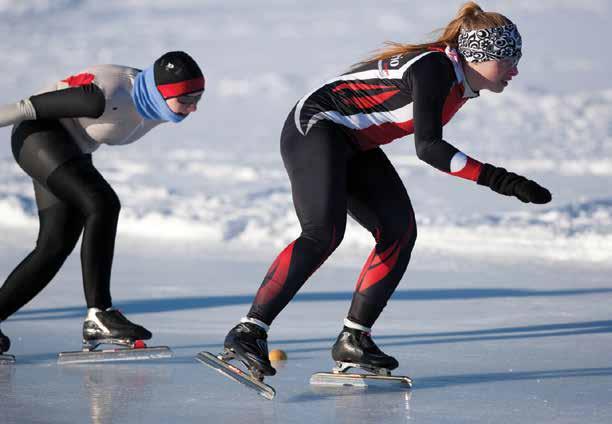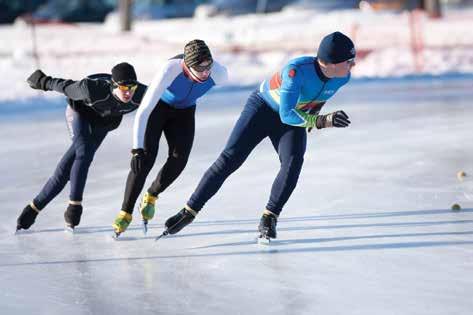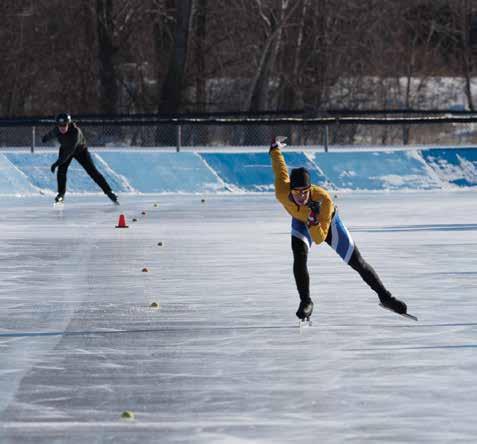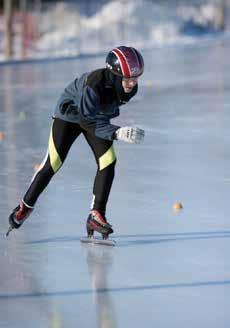
4 minute read
The addictive thrills and spills of speedskating
THE LONG BLADES BECKON
BY DAVE BROWN
Advertisement
Ah, the need for speed. If you’re a speedskater living around Ottawa, you know the rush of the sound of the ice as you plant one blade in front of the other and race around Brewer’s outdoor oval rink. For many, it’s truly addictive.
Once you’ve experienced the thrill of strapping on long, razorsharp blades and flying around an oval track at speeds close to 30 kilometres an hour, the rush is too much to ignore.
And who doesn’t recall the excitement of watching shortand long-track races during past Olympics? And special kudos to Ottawa’s own Kristina Groves, who won four Olympic medals — three silver and a bronze — as well as 18 world championship medals.
But aside from Olympians, past and future, there are hundreds of children and adults learning to speedskate this winter – just for the fun of it.
The outdoor Brewer Park Oval — a 400-metre Olympic-sized speedskating track across from Carleton University — beckons both children and adults. For a winter country, Canada has surprisingly few speedskating ovals, and the Brewer facility is one of only two in Ontario.
Ottawa’s two speedskating clubs have long been involved in the building and maintenance of the oval and rinks. Volunteers from the Ottawa Pacers Speed Skating Club and the Gloucester Concordes Speed Skating Club spend many cold nights pouring water on the fields of Brewer Park.
This year they anticipate more than 4,000 skaters. Accessible by car, bus or the O-train, visitors can skate on either the standard indoor or the outdoor oval skating rinks. When you speedskate you skate in a counter clockwise direction as fast as you can, trying not to lose control only to slide into the cushioned walls or snowbanks.
Skaters practise to obtain a smooth transition from short steps at the start of the race to long, smooth and efficient strides to maximize their speed. The speed comes from crouching low to reduce air resistance while, at the same time, allowing the leg to extend to the side during each push.
Let’s take a closer look at the sport.
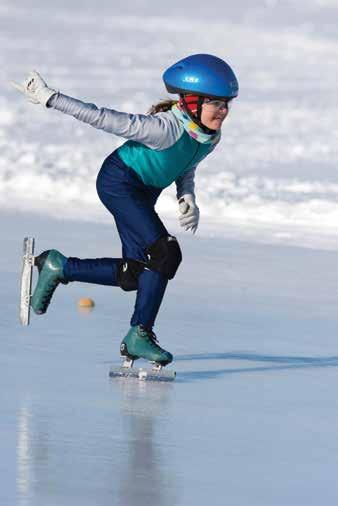
RACE TYPES
Whether you’re seven or 70, either type of speedskating mentioned here will develop your strength, agility and co-ordination.
Short-track speedskating is racing on ice on an 111-metre track in an indoor arena. It is tactical and requires good technique, strength and endurance. Short track is packstyle racing among groups of four to six skaters. A standard meet will have four sets of races at different distances, which vary depending on the age of the skaters.
Long-track speedskating is raced on a 400-metre track. It is tactical (dependant on the distance and pace) and also requires good technique, strength and endurance. Long track can be pack style (mass start with multiple skaters) or Olympic style (two skaters on the track). A standard meet will consist of sets of races at different distances.
HISTORY
The roots of speedskating date back over a millennium to Scandinavia, northern europe and
the Netherlands. Local natives added bones to their shoes and used them to travel on frozen rivers, canals and lakes.
Later, in the 16th century, people started seeing skating as fun and even a sporting activity. The sport spread, and in 1592 a Scotsman designed a skate with an iron blade, leading to the growth of speedskating.
By 1850, North America had discovered a love of the sport, and went on to develop the all-steel blade, which was both lighter and sharper. Then, in 1889, the Netherlands organized the very first world championships, and the sport has been growing ever since.
MANDATORY EQUIPMENT • Speed skates (sometimes for rent from clubs) • Helmet (hockey, bicycle or in-line helmet allowed for practices). It is mandatory to have a speedskating ISU certified helmet (LAS or LG) for short track meets • Safety glasses • Neck guard with bib • Cut-proof gloves • Knee pads • Shin guards
Organizers and local clubs want Ottawans to come enjoy this experience. Children specifically embrace speedskating because this allows them the fun to both skate and race. It is also strongly recommended as a family and lifetime activity.
Surprisingly, the rink is a neutral ground. In speedskating races, boys skate against girls, tall skate against small, and so on. It’s the skater with technique and strategy that wins the day.
Speedskating is an individual sport where you choose which level to pursue, and where and how often to skate. By joining a local club you also get the social and support benefits of a larger group – the camaraderie, coaching, and access to ice time and equipment. What a great new sport to try this winter. Here’s how to contact the clubs: Ottawa Pacers ottawapacers.ca) and Gloucester Concordes (gloucesterconcordes.ca)
~ Originally published in Dave’s weekly Outdoor Life column each Saturday in the Ottawa Citizen.
